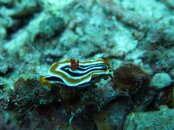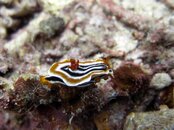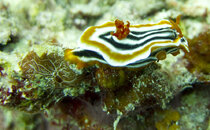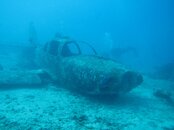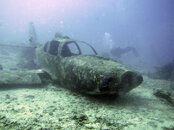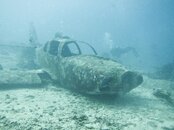On my last trip I used the S90 in Canon case without external strobe -- I wanted to travel light. It's limited without the external strobe, but you can get the job done with a compact setup.
Here are some hacks I use to compensate for no external flash:
For macro, you can use the internal strobe (from say 3 inch to 16 inch distance). Make sure to attach the strobe diffuser or the flash only lights the top of the image. For really close macro under say 3 inch working distance, the internal strobe will not be diffused enough, so turn it off and jack up the ISO. For wide or distance shots, turn off the strobe because it is too weak to do anything other than make backscatter. The internal flash drains the battery quickly so you may have to change it after only one dive, instead of 2-3.
ISO: Near the surface where there is plenty of light, I use ISO100, but deeper I set the ISO to 400.
Mode: I use Av setting at F2 and make sure the shutter speed ends up 1/100 or shorter to stop motion.
Image Size: I shoot Large + Raw, memory cards are cheap and RAW is better for post processing to restore white balance.
For white balance, the UW setting is useless, or maybe useful only to limited depth, so I use custom white balance on a white slate. I don't have to do this, I can always correct the RAW image, but sometimes it saves time to use the JPEG image with cropping/tweaking in Photoshop. Shooting RAW is definitely the way to go though, because you can usually rebalance the color with software. I don't like to spend a lot of time fussing with the photos like a pro would, so often I use the JPEG with the famous Mandrake Photoshop Plugin for red correction. But sometimes the JPEG is not corrected well so manipulating the RAW image is the way to go. Nice to have all options.
For examples I am attaching several pics showing a macro shot and a wide shot processed in three ways: JPEG uncorrected, JPEG corrected for red (Mandrake), and RAW corrected and converted to JPEG for posting. Not great photos, but you can see how the Mandrake plugin works for JPEGs, and what you can do with RAW. As you can see, the Mandrake plugin introduces false color to the airplane image, but I prefer it. On the other hand, the nudibranch couple processed from the RAW image looks more like the original colors I remember. Sometimes I prefer the Mandrake result, sometimes the RAW.
You'll definitely get better results with an external strobe, but these shots illustrate how you can manage without one.







